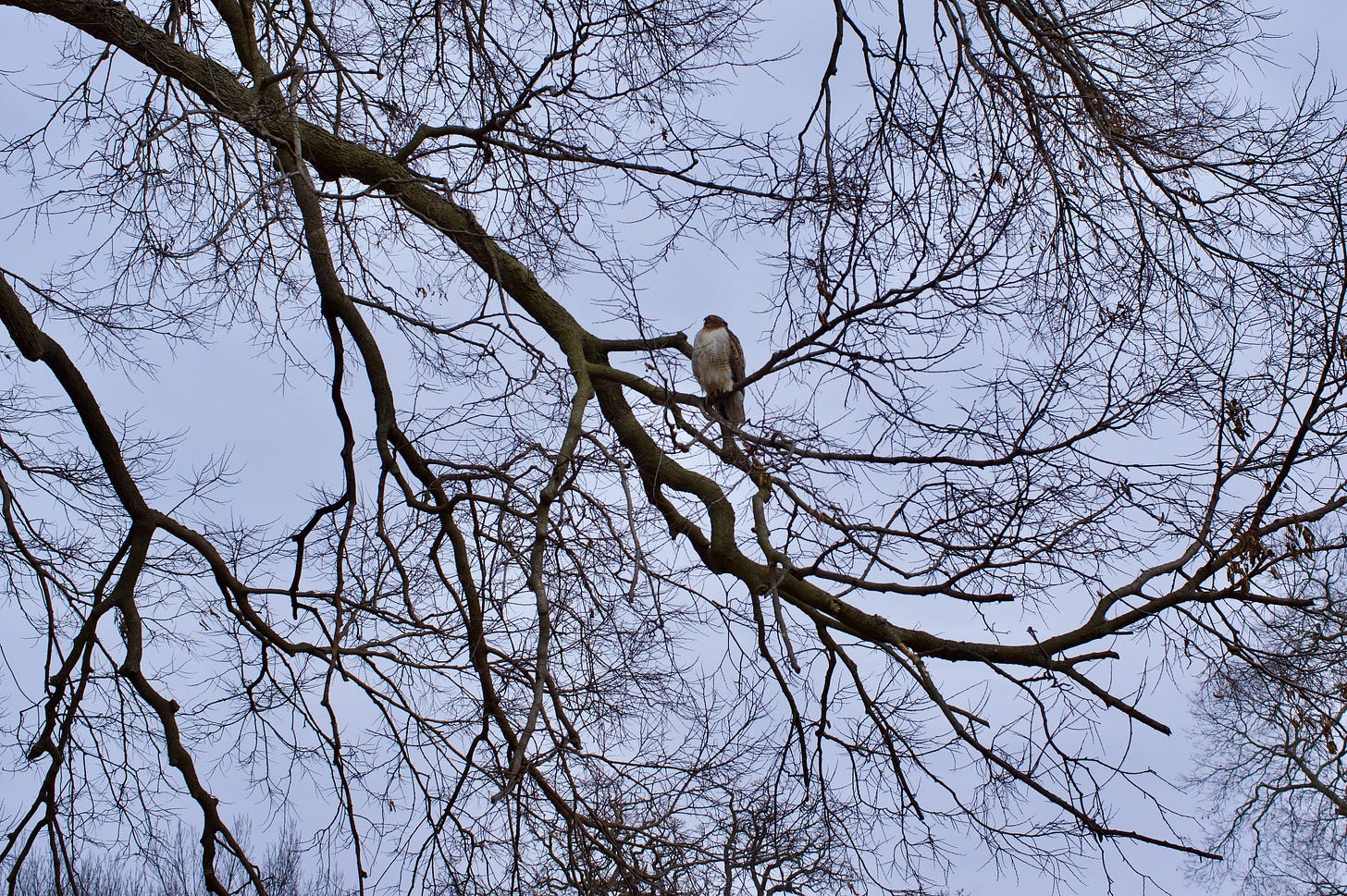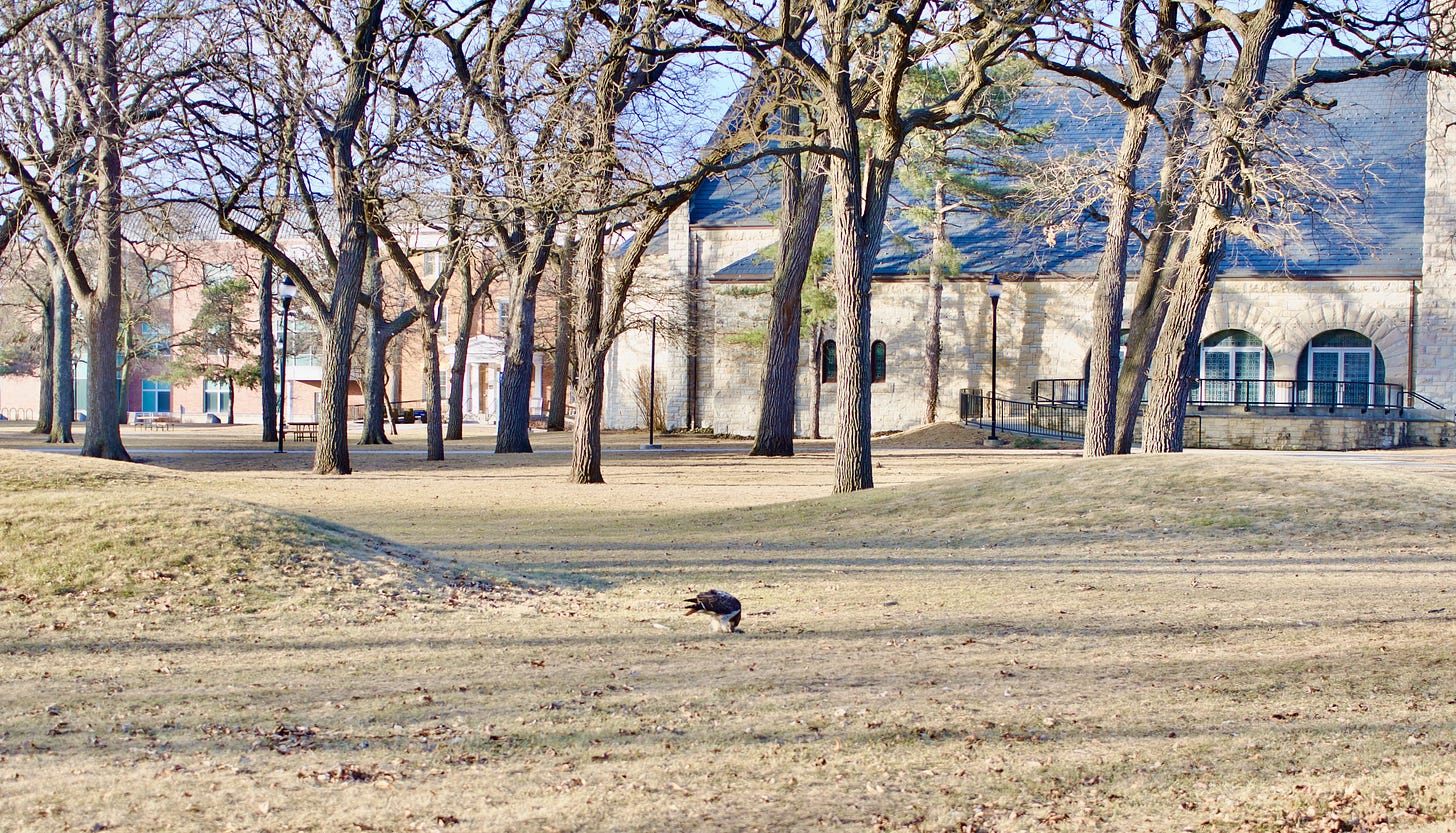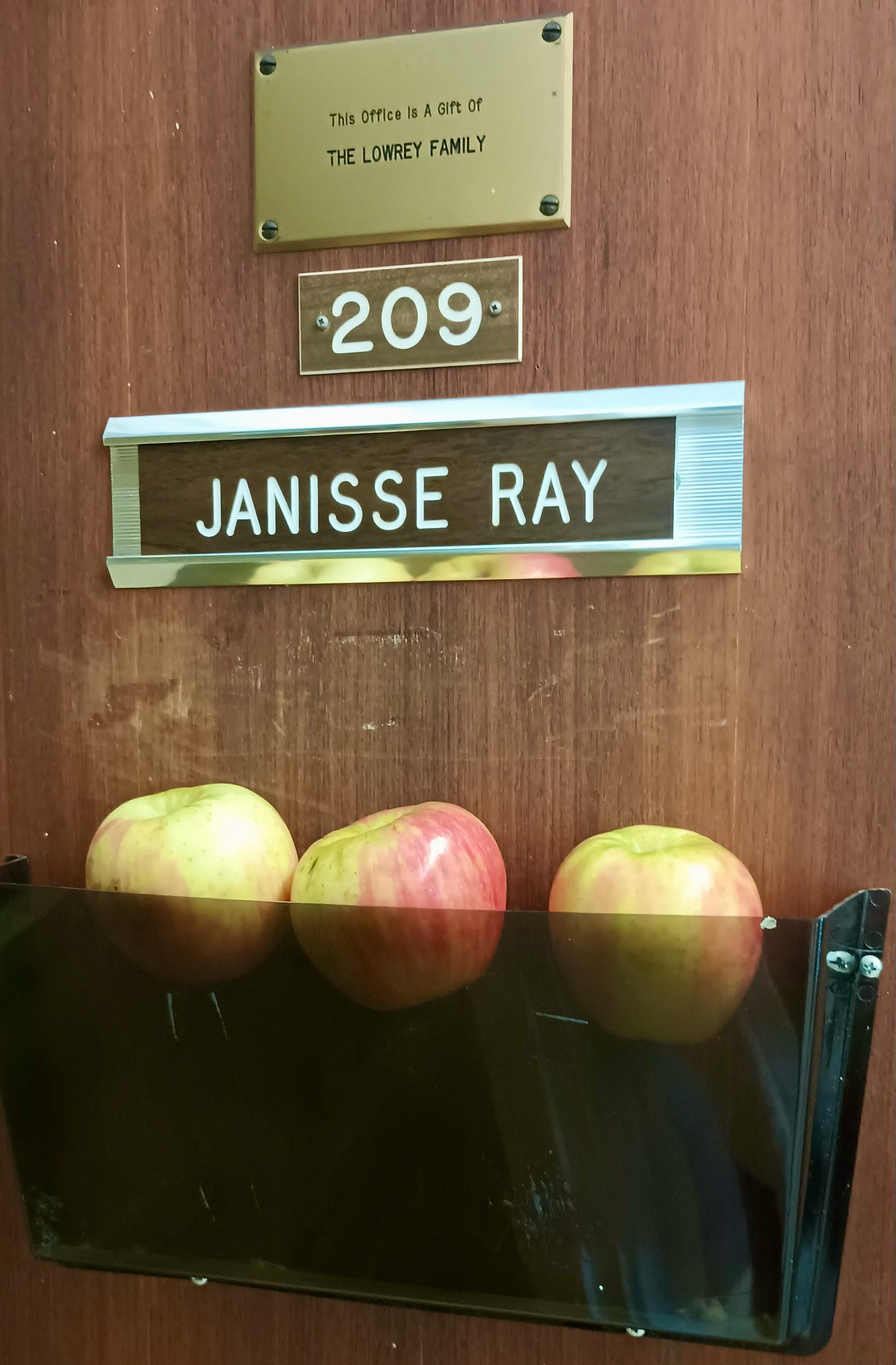—Beloit College, Beloit, Wisconsin
1.
ON THE QUAD A STUDENT was acting strangely. She stood at sidewalk’s edge pointing her phone toward leafless branches of trees. She took a photo, walked a few steps, swiveled, and took another photo. She walked again then turned, as if some image in the trees had become a magnet whose force-field she couldn’t break.
I was passing by, baby in arms. “Are you photographing trees?” I called to the student.
“Look!” she said. “There’s a red-tailed hawk in that tree! Do you see it?” A light-colored bundle perched on the bare limb of an oak fifteen feet above the ground. “It hasn’t moved,” she said. She was breathless with excitement. “I walked right underneath it!”
“Wow.” I said “Thank you. I wouldn’t have seen it.”
She aimed her phone-camera again. “This is so amazing,” she said. “A red-tailed hawk!”
2.
The day I arrived to Beloit College my guide pointed out an unusual feature of the campus—it was built on sacred ground, place of mounds built by Native Americans. The mounds are different sizes, only two or three feet high at their highest, and the largest maybe twenty feet across. In the quad are five or six of these. “We don’t walk on them,” the guide said.
The hawk sits directly above one of the mounds. I walk, holding the baby, across the grass, avoiding the mounds, and stand below the bird. It gazes down, unafraid and unmoving.
Chris, my new friend Chris, needs to see this. Before I came to Beloit I only knew Chris through emails, but something magical happened when I arrived. I felt as if I’d met a true friend, and I already regretted the years ahead when I wouldn’t get to canoe rivers and walk trails with him and his family.
“It’s hunting squirrels,” Chris said when I brought him to a window in the old Carnegie Library and pointed out the hawk perched on the same spot of the same branch. “I’ve seen this before. This is winter, it’s hungry.”
Thirty minutes later Chris tapped on my office door. “It got a squirrel,” he said.
“For real?”
I rushed back to the window, Chris following—two nature nerds in an English Department. Now the hawk was on the ground, tearing apart a fat squirrel with beak and talon. The squirrel was being stripped to red.
The story could end there, leaving a queasy feeling in my stomach, death so sudden, so close. Except that Chris, ever watchful, spotted something in the tree where the hawk had waited patiently for so long.
A hole six inches wide opened to the heart of the tree, where in the minus-zero weather of Wisconsin winter, the squirrel had lived. The hawk, scholar of prey, had watched this hole.
And now, above the opening, squatted a second squirrel, gray-brown fur spiked against the cold, tail curled above her back. There was no mistake about what she was doing. She sat and watched the scenario unfolding on the ground.
“The mate,” Chris said.
The second squirrel did not flinch as the beautiful hawk devoured her nest-mate. Her face did not crumple. Her eyes were tearless. She made no motion at all, not a quiver, her paws still. That she was watching was obvious. She sat gray and statue-like beside the door of her house, witnessing.
3.
My stomach felt like a jar of milk shaken and curdling.
“Remember her brain is the size of an almond,” Chris said. “She doesn’t feel anything.”
“You don’t know that,” I said, so vehemently he didn’t respond.
Maybe the squirrel was thinking of all the joyful games she had played with her mate, the two of them chasing each other between trees, choosing a burr oak to climb, circling around and around, his handsome feathered tail brushing her face. How they would climb to a high spot on the trunk, even with the church steeple, and look out at the campus, all its pretty buildings, watching students walk between classes.How he had curled his fat body around hers night after night in the cavity of the tree. How they had spoken of the mounds, how they felt the spirits of the ancestors, and how glad they were the quad was returned to them.
Maybe she was thinking of all their conversations about what to do, “Do you want to go look for hickories?” “Do you remember where we buried those acorns over near Sanger?” “Do you think it’s safe to go out now?” “Is that hawk around?” “Do you hear anything?”
Even the trees converse with each other. Why wouldn’t the squirrels?
4.
I’ve been in force-fields that I couldn’t break. I’ve been caught in obsessions, held in nets. I’ve been fed by micorrhyza.
Someone taps lightly at my door. It is the professor Joseph, holding a brown paper bag folded shut.
“I made you a loaf of bread,” he says. “It’s sourdough, with flaxseed and local wheat and a little bit of local rye….” Actually I will not remember what he said. I am thinking, “Oh my god, it looks like a small mound.”
What I mean is, it looks like a holy place.
5.
Back home, one of my friends will bring apples to my little office in town. He sits down in a chair across from my desk, takes out a pearl-handled pocketknife. “Honeycrisp,” he will say, and begin to cut wedges. Honeycrisp is the variety.
As we eat we talk about trees.
“Did you get the lumber stacked from that cedar?” he says. The cedars went down in one of the last hurricanes.
“Done,” I say.
“Where did you stack it?”
“Raven built an extension on the barn.”
When the apple is finished, my friend shoves on. We both love trees, he and I. Longleaf pine is our favorite. We both love apples. Our favorite fruit.
My friend had back surgery and I didn’t see him for a month. I saved a very large apple, a Cosmic Crisp, so long it began to wrinkle.
When I study the bark of the burr oak—as deeply grooved as I’ve ever seen—I think of him.
6.
A student caught me on the grass. The baby was in a backpack carrier and I was photographing the strange, peeling bark of shagbark hickory.
“Ma’am,’ the student called. “Ma’am?”
I turned.
“We don’t walk on the grass,” he said. “Those are mounds over there. They are burial places. You walking on these mounds is like walking on dead people.”
“Oh, I’m sorry,” I said. “I know not to walk on the mounds. I didn’t know not to walk on the grass.”
“We treat all this ground like a cemetery,” he said.
“Sorry,” I said again, returning to the sidewalk, thinking of the hundreds of cemeteries I’ve walked.
Does a sidewalk not count? Is it not a transect through holy ground? If concrete separates your body from the earth’s body, and from all the bodies that the earth holds, then are you not present? Does the sidewalk make you absent from the earth? Does the sidewalk protect the holiness or does it shatter the holiness? Is there a difference between a foot on holy ground or a foot on a sidewalk through holy ground?
I would like to ask the spirits of the lonely dead what they wish me to do. From what I’ve heard, the ancestors like our company.
7.
Something strange has begun to happen in my classroom. When I arrive, Tuesday or Thursday morning, the door is usually locked. I unlock it and flip on the lights and turn on the heat. I put down my things, get out my laptop, and connect it to a projector.
One of my students comes in. “Good morning,” I say. “How are you?” I get engulfed in conversations as my students arrive out of snow and ice.
The first time the strangeness happened was like this: I reached for my book bag to take out my journal.
Beside my bag sat an apple. It was a large apple—four times the size of most apples. A Jonagold, perhaps.
“Whoa,” I said. “Where did this come from?”
I looked around the room. My students glanced up, blinked at the apple, and looked at each other. They shook their heads.
“Did one of you give me an apple?”
They shook their heads again, no.
Had the apple been there when I put down my things? Had someone the previous night left it? Would they come back for it?
I took it and ate it, thinking of my friend.
The next class, I hung my coat on a chair and settled my book bag into the seat. I turned to speak to someone. When I took my place to start class, two apples waited in the chair beside my bag.
“What?” I said. “Who is leaving me apples?” I looked around the room—faces blank, heads shaking. No.
“Is this magic?” I said. “Apples just keep appearing.”
No one said a word.
8.
I got a message in my college email that a snowstorm was coming. Park off the street, it said, so the snowplows can pass. Classes will not be cancelled. Snow started late one afternoon and fell all night, dropping half a foot on the ground. Midwesterners take snow seriously, I learned. All night snow plows passed my apartment, their blades grating against asphalt, their warning lights throwing yellow streaks through the bedroom. At 1 a.m. my neighbor brought out his walk-behind snow blower to clear the sidewalks in our neighborhood.
Two days later another snowstorm arrived with the same warnings. My students found places to sled and build snowpeople.
I braced for a forecast of bitter cold. One morning the temperature was 0 degrees, up from a negative 7 or 8 during the night. I spent three winters in Montana and five in Vermont, and I thought I knew winter. But this Wisconsin winter kicks my butt. When I prepared to trudge the four blocks to school I put on four layers. Then I strapped the baby in a pack on my belly. She was wearing three layers. Last, I put on my coat and buttoned it around both of us. I looked pregnant, except a little wool-covered head was poking out.
8.
My Georgia baby does a funny thing when I take her out. She sticks out her tongue. Apparently she loves the taste of winter. If the wind is blowing, she sticks out her tongue and laughs.
9.
One morning I geared up, baby on the front, backpack on my back, and I stepped out my door. Two concrete steps lead down to a paved walk, and the walkway to a sidewalk, and the sidewalk to campus.
I stood beneath the awning of my door. The ground was wet, as if rain had fallen in the night, except the night had seen more fog than drizzle. I took a step out into the day. Instantly my feet slid out from under me. How I managed to land on my back, with the baby protected, I do not know. The two of us fell down the steps onto the walk. Unhurt.
Underneath a sheen of glistening rain was the thinnest sheet of ice imaginable. It covered everything.
I know “black ice.” This was not black ice. Later I would hear someone call it “freezing rain.” It was not freezing rain. It was more like freezing fog. Ice fog, rime fog, frost fog, rime ice.
That day if I had to walk anywhere, I walked on grass not pavement. I walked as if ice-skating. Instead of walking I drove to school, carefully, the baby and I. Out of the dozen students in my writing workshop, six had fallen that morning.
One of my colleagues is married to an ER nurse who works at the hospital in Madison. He told me that 71 patients arrived to the Madison ER that morning for falls.
Another told me about a visiting professor a few years ago who fell on ice and broke his ankle, had to have a pin in it.
My old friend Michael used to say that luck comes to the brave. But sometimes what comes is just luck.
10.
The first time, one apple appeared. The next time, there were two. The third time, three apples were squeezed into a plastic mail receptacle hanging on my office door.
For our next class session, four apples appeared in the chair beside mine. To be honest, the apples began to spook me a skosh.
I watched closely for apples on the following Thursday. I was leaving the classroom when I spotted them. Five apples were lined along the north window.
I didn’t touch them. I planned to return and take a photo, but when I went back into the classroom with my camera, the apples were gone.
11.
The hawk returned to campus. I learned of this from the chickadees, who spotted the hawk first and began to sound their alarm call. Now the weather was warmer, snow melting, and I began to see more birds. They were on high alert with the hawk hanging around.
12.
Apples keep appearing. Squirrels keep disappearing. I am caught in the force-fields of all the appearances and disappearances, grateful that in the end they seem to even out.
About Chris Fink
Chris Fink is the author of two short story collections, Farmer’s Almanac: A Work of Fiction (2013) and Add This to the List of Things That You Are (2019). He is a professor of English and Environmental Studies at Beloit College and editor-in-chief of the Beloit Fiction Journal.
A journal editor for more than 20 years, Fink founded two national short story prizes—the John Steinbeck Award and the Hamlin Garland Award. Recent stories have appeared in the Mississippi Review, New Orleans Review and Witness. He is a regular contributor to Northern Public Radio, where he produces radio essays about the intersection of the self and the natural world.
Fink received his PhD from the University of Wisconsin Milwaukee and was a founding faculty member of the MFA program at San Jose State University. In the summer he teaches a course called Writing Wilderness in the Boundary Waters Canoe Area, one of his favorite places in the world. He lives near Beloit, Wisconsin with his wife Breja and daughter Iris.
Update
My son Silas flies into Milwaukee next Wednesday. I teach my last class on Thursday, and soon after we will leave driving south. We should be back at the farm by next Saturday.
Current Online Course
Then I will resume the current Magical Craft of Creative Nonfiction course, which I put on hold this week. My neighbor Kayla, a speech therapist at the local high school, has been watching the baby while I teach, but during the last session Little Fawn cried for 1 1/2 hours. Finally Kayla brought her over to me. That kind of crying is not good for any of us. Folks in the course have been extremely kind and understanding. We will finish the last two sessions, the last two office hours, and an open mic in March.
Next One
I plan to teach a cohort of Magical Craft of Creative Nonfiction in the summer, if all goes well. It’s on Tuesday evenings starting July 25 and running through Sept. 2. Registration is at my website.
If You Have Ordered Books
I brought a box of books with me to fulfill orders from my website, but I have depleted my stock. If I owe you a book, I’ve sent you an email, with apologies. I will get these books in the mail first thing after I return. I apologize for the inconvenience.
Nature Journaling School—Journaling the Garden
People are very excited, as am I, about this workshop series for Nature Journaling School. We’ll have some fabulous guest artists that include Clare Walker Leslie, Nina Veteto, Rachel Michaud, Jasmin Pittman, Susan Loeb, and Madeleine Jubilee Saito.
There is no shortage of tickets since we are online and have plenty of space. Join us if you can. Tuition is by donation, so you decide.













Delighted always with pictures of the baby. Impressed that you just take her with you, undaunted, enriching her life and not letting her interfere with your own. Delighted also that you are in my life and communicate so beautifully - and - that you love apples. Thank you.
I love bur oaks. Midwest Oak Savannas were one of the early habitats where I practiced the art of fire healing on the landscape.
I had a declining bur oak that brooded over the exercise ring on the horse farm in Illinois where I was writing my Master's thesis. Each day, I would be glance out my window and be distracted from my work to daydream about what that tree knew, well before any white face walked under its branches.
Later, I lived in a neighborhood in Dayton, Ohio named five oaks. It was named after five large bur oaks that had stood along a dirt farm road, then transformed to housing blocks, and finally to a bus route. Amazingly, three of the old oaks has survived all that hubbub and one of them was in my back yard. I paid homage to the tree by restoring a slice of forest strata right there in the city. I planted two dogwood trees under it with a carpet of woodland spring ephemerals ringing its root crown. A park director and writer came by and cored the tree. He said it was at least 350 years old. That was 35 years ago. I was back there last month. The house is in disrepair. The tree remains.